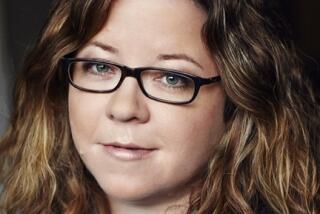‘Making a Murderer’ probes a true-crime puzzler
- Share via
“Making a Murderer,” Netflix’s new true-crime documentary is as unnerving as it is addictive, in part because it is so addictive.
Over the course of 10 hours. writers-directors Laura Ricciardi and Moira Demos tell the story of Steven Avery, a Wisconsin man who served 18 years for a sexual assault he did not commit before being exonerated by DNA evidence. Then, just as he prepared to sue the county and police department that had put him in jail in the first place, Avery was accused and later convicted of a horrific kidnapping and murder that he insists he did not commit.
With painstaking, and often painful, detail, “Making a Murderer” reconstructs how all of this came to pass. What emerges, at least from the four hours Netflix made available, is a disturbing portrait of tribal politics in small-town America and a chilling reminder that the criminal justice system has many more sides than scripted television’s carefully curated tales of “law and order.”
See more of Entertainment’s top stories on Facebook >>
Part of a well-known if not universally beloved family in the small town of Chilton, Wis., Avery had a history of crime both petty (robbery) and brutal (he set fire to the family cat). More important, he had a hostile relationship with at least one cousin, a woman married to a local police officer who was vocal in her hatred of Avery.
In 1985, when Penny Beernsten was sexually assaulted while running along Lake Michigan, her initial description of her assailant provoked one member of the Manitowoc law enforcement to remark “that sounds like Steven Avery.” Beernsten then picked Avery out of a lineup and identified him specifically in court. Despite Avery having multiple alibi witnesses for the time of the attack, he was convicted and sentenced to 32 years.
The first few hours of “Making a Murderer” detail how police and the district attorney’s office quickly settled on Avery as the perpetrator (despite there being another suspect similar in appearance and with a history of sexual assault), and efforts by Avery’s family and later members of the Innocence Project to get him exonerated.
Then, just as Avery was preparing to sue those involved, he was charged with the horrific abduction and murder of Teresa Halbach, a young photographer last seen heading to shoot a car Avery had restored.
Here the story takes a bend toward the surreal, with evidence that seems to mysteriously appear after several initial searches, and Avery’s young and mentally challenged nephew clearly prompted into telling a fantastical tale of rape and murder that is not supported by any physical evidence and later denied by the addled nephew himself.
That Avery’s presence in the series is provided almost exclusively by telephone makes his eventual conviction a forgone conclusion, and “Making a Murderer” the latest entrant in the hot new subgenre of potentially corrective true-crime television.
True crime stories have long been popular on TV, and the rise of advocates like John Walsh added an interactive element: shows like “To Catch a Predator” chronicle undercover sting operations while “America’s Most Wanted” encouraged audience members to aid in the capture of elusive criminals.
The famous exoneration of the West Memphis Three after two HBO documentaries about the case generated attention, and additional evidence, added even more potential: Television documentaries could offer justice to a cold case.
They could also do big business, as the wild and unprecedented success of the podcast “Serial” recently proved.
Both of these aspects came to fruition last year when HBO’s “The Jinx” caught long-time murder suspect Robert Durst apparently confessing to his crimes. After the finale aired, Durst was arrested on a gun charge that could lead to the case of his wife’s murder being reopened.
Even amid the scripted revolution, “The Jinx” was one of the most talked-about shows of the year.
With its full-season dump — surely no other outlet would commit to 10 hours following a story in which the ending is public record — “Making a Murderer” is able to spend even more time sifting through the evidence, police tapes and interviews. And if the format seems initially very familiar — the news clips, the emotional family members, the emphatic lawyers — it quickly widens its scope to things beyond the actual crime.
“Making a Murderer” features the sort of people who are rarely seen on television in any real depth, the sort of people too parodied or dismissed in reality series, glossed over in the cultural conversation until they are evoked, en masse, during election years as “real Americans.”
In many ways, Steven Avery is the flip side of Robert Durst, in both tale and milieu. Where Durst’s wealth and urban acumen protected his bizarre lifestyle and allowed him to evade prosecution; Avery’s poverty and cultural isolation made him an easy target. He, and the various members of his family filmed here are striking in both their tireless insistence on his innocence and their alarming lack of moral outrage. The lawyers that aid them in their defense seem at times mystified by the byzantine nature of the town and the county, the quiet plodding nature of Avery’s parents and, indeed, Avery himself.
Whether or not these people, and their terrible ordeals, should be offered up for our binge-loving entertainment is a whole other issue. Clearly, Ricciardi and Demos are on the side of justice, attempting to shed light on the dangers of imperfect police work and the very real potential for conspiracy. But when they showcase the awful thrill with which some members of the media reacted to the “great story” of Avery’s second arrest, it’s tough not to see a double standard.
It is a great story, which is why they and Netflix chose to tell it.
Even more worrisome is the marginalization of the victims, and their families, in these sorts of series. Although they focus on men, “Serial,” “The Jinx” and “Making a Murderer” are all bound by dead women, who remain dead no matter who goes to jail for it.
Twitter: @marymacTV
------------
‘Making a Murderer’
Where: Netflix
When: Anytime, starting Friday
Rating: TV-14 (may be unsuitable for children under the age of 14)
More to Read
The complete guide to home viewing
Get Screen Gab for everything about the TV shows and streaming movies everyone’s talking about.
You may occasionally receive promotional content from the Los Angeles Times.







